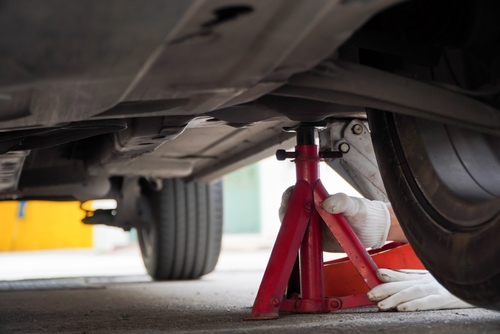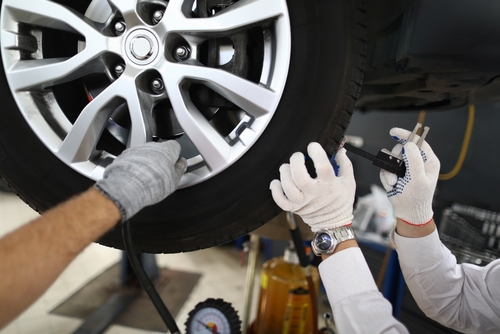Tire maintenance & safety
Tire inspection checklist: Your how-to guide

Best price guarantee
Tire replacement coverage
24/7 roadside assistance
Easy returns
Tire maintenance & safety

Your car is safe, it’s reliable, and it almost never lets you down. And even though the manufacturers built it to never break down, the impact of the vehicle's tires are out of their hands.
Tires are the contact point between vehicles and the road beneath. If you neglect your tires, it’s only a matter of time before you wind up stranded on the side of the road with a flat tire, and you’d better hope it doesn’t happen in the winter, either.
Some things are unavoidable, as there’s no way to spot that nail on the road that’s about to ruin your day. Most things can be controlled, though. For example, avoiding running a tire down to the cords is something you can prevent. Performing regular inspections is how you do it.
In fact, we’ve put together a step-by-step guide for you to follow! Here are the details on everything you need to look out for so you can spot them.
Starting simple, take a walk around the car and look for any obvious issues. Something like a flat tire is sure to jump right out at you, but you don’t want to limit your eye to just that issue. Keep an eye out for any swelling of the sidewalls, cracks, or even protruding objects that have punctured the tires.
Next, you’ll want to take a look under the car. This time we are looking for any issues that will jump right out at us. You can feel tempted to skip this and wait until later to get a look at the inside of the tires. The only reason we recommend doing it now is just in case there are any pressing issues that you’ll want to address immediately.

Now it’s time to get up close and personal. You’ll want to jack the car up so you can give a thorough inspection of the tires. Make sure to do so as safely as possible, and be sure to use jack stands and wheel chocks. Remember, you’ll want to take a look at the inner portion of the tire, and you don’t want to go under there without the car properly secured.
At this stage, you want to take a closer look at the tires' outside, inside, and tread. Give them a spin, and look for any signs of damage, severe wear, or dry rot. You absolutely want to make sure that all of the wheel weights are in place.
If you’re not sure how many there should be, you can use one of the other tires for reference so long as they are an exact match to the tire you’re examining. These aren’t permanently mounted to the wheels, and they can come off in some situations. If they do, they’ll cause a vibration in the wheel.
With the car on the stands, it’s a good time to inspect the tread depth. You can do so with a tread depth gauge, a quarter, or you can use a penny. You want to make sure that you have at least 2/32-inch of tread depth—you can verify this with a penny by making sure Lincoln’s head is covered by tread when you place him in there head first.
We suggest checking tread now because it’s easier to check the tread on multiple locations on the tire. This will ensure that you have even wear across the tire.
Even with a tread depth gauge, you may miss low spots if they're present. Not only that, you'll want to make sure that the wheel isn't bent. By spinning the tires and watching for any irregularities, you're verifying that the tire isn't out of round and that the wheel isn't bent. Any wobbles or deviations are clear signs of issues.
Wheel chocks are a must for inspecting drive tires. The car may roll when they are in the air, even when it's on jack stands. So don't take the risk no matter how level the ground appears.
Before moving onto the next tire, give the wheel assembly a shake from side to side and top to bottom in a push-pull manner. If there’s any movement , it means that your wheel bearing is bad, and your tire will wear rapidly. In the case that you find a bad wheel bearing, you will want to deal with it immediately.
Your tire inspection is nearly at its end. That means it’s time to take it off the jack stands and get it back on solid ground. Once it is, give the front and rear suspension a jolt to settle it out. It might also be a good idea to roll it back and forth to make sure the steering can get back into alignment. This may be a little overkill, but it doesn’t hurt to make sure everything is exactly as it should be.
The last step is to go to each of the tires and make sure your tire pressure is in check with the vehicle’s door jamb or owner’s manual. This is something you want to do at least once a month anyway, but doing it now only ensures everything is in perfect order.
You should be giving your tires a quick visual inspection every time you drive and checking tire pressure at least once a month. As you would expect, that also means that you should be inspecting your tires at least once per month. And that’s just with average driving conditions.
If you subject your vehicle to particularly harsh environments or drive more than the average person, you should inspect your tires more frequently.
Yes. You can’t take it on faith that brand new tires or replacement tires are in perfect condition. Just because they are professionally installed doesn’t mean the technician can’t miss something. It’s not out of the realm of possibility for something in the parking lot of the tire service center or on the road home to cause issues either. Your best bet is to give the tires a once-over to make sure they’re ready for use.

You might be performing a tire inspection because there’s an issue while driving. It might be a shake, vibration, or a sound that you can’t directly link to any problems with the tire. If that’s the case, it might be on account of faulty suspension components. It’s best to take the vehicle to a professional who can help you determine what the source of your problem is.
Nine steps might seem like a lot, but it’s not that bad. It can seem intimidating, but the reality is that the entire process should take you under an hour to complete on all four wheels. Think about it, that’s less than one hour per month.
It can be tempting to leave it at step one and just assume that a quick visual inspection is all it takes. But all it takes is one small nail stuck in the tread to cause a major headache. Your life does depend on your tires, and it’s worth making sure that they’re in order.
Search By